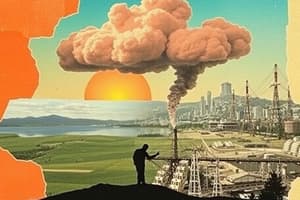Podcast
Questions and Answers
What is the mean value of the variable DJF?
What is the mean value of the variable DJF?
- 0.3276271
- 0.3023729
- 0.3861017
- 0.3769492 (correct)
Which variable has the highest standard deviation?
Which variable has the highest standard deviation?
- Monthly average
- MAM
- SON
- DJF (correct)
What is the minimum value of the variable JJA?
What is the minimum value of the variable JJA?
- -0.41
- -0.24
- -0.22 (correct)
- -0.32
What is the maximum value of the 'Trend' variable?
What is the maximum value of the 'Trend' variable?
Which of the following R functions would you use to find the average of the 'Monthly average' variable?
Which of the following R functions would you use to find the average of the 'Monthly average' variable?
What has been the trend in global annual temperature since the Industrial Revolution?
What has been the trend in global annual temperature since the Industrial Revolution?
Which factor is primarily responsible for the gradual increase in global temperature?
Which factor is primarily responsible for the gradual increase in global temperature?
How does carbon dioxide (CO2) emissions affect the atmosphere?
How does carbon dioxide (CO2) emissions affect the atmosphere?
What is emphasized as crucial for sustainable development in the context of climate change?
What is emphasized as crucial for sustainable development in the context of climate change?
What period is the analysis of the impact of CO2 on global temperature focused on?
What period is the analysis of the impact of CO2 on global temperature focused on?
What type of gas is carbon dioxide (CO2) classified as in regards to global warming?
What type of gas is carbon dioxide (CO2) classified as in regards to global warming?
What is the proposed role of young people mentioned in the abstract regarding environmental challenges?
What is the proposed role of young people mentioned in the abstract regarding environmental challenges?
Which of the following statements is true about the rate of increase in global temperature over the last 40 years?
Which of the following statements is true about the rate of increase in global temperature over the last 40 years?
What major human activity has significantly increased atmospheric CO2 levels since the industrial revolution?
What major human activity has significantly increased atmospheric CO2 levels since the industrial revolution?
What percentage of human-emitted CO2 can natural sinks potentially absorb annually?
What percentage of human-emitted CO2 can natural sinks potentially absorb annually?
Which of the following datasets was used to analyze the correlation between CO2 emissions and global temperatures?
Which of the following datasets was used to analyze the correlation between CO2 emissions and global temperatures?
How did CO2 emissions change from the 1960s to the last recorded year?
How did CO2 emissions change from the 1960s to the last recorded year?
What was the purpose of examining data from 1959 to 2017 in the analysis?
What was the purpose of examining data from 1959 to 2017 in the analysis?
What was the trend in annual CO2 emissions observed in the 20th century?
What was the trend in annual CO2 emissions observed in the 20th century?
Which statistical functions can be used to calculate the average of a dataset in the analysis?
Which statistical functions can be used to calculate the average of a dataset in the analysis?
What natural processes contribute to CO2 emissions apart from human activities?
What natural processes contribute to CO2 emissions apart from human activities?
Flashcards
Global Warming
Global Warming
A gradual increase in the Earth's average surface temperature.
CO2 Emissions
CO2 Emissions
Release of carbon dioxide into the atmosphere, often caused by human activities.
Greenhouse Gas
Greenhouse Gas
A gas that traps heat in the Earth's atmosphere.
Climate Change
Climate Change
Signup and view all the flashcards
Carbon Dioxide (CO2)
Carbon Dioxide (CO2)
Signup and view all the flashcards
Global Temperature increase
Global Temperature increase
Signup and view all the flashcards
R Programming
R Programming
Signup and view all the flashcards
Industrial Revolution
Industrial Revolution
Signup and view all the flashcards
Calculate Mean
Calculate Mean
Signup and view all the flashcards
Calculate Standard Deviation
Calculate Standard Deviation
Signup and view all the flashcards
Minimum Value
Minimum Value
Signup and view all the flashcards
Maximum Value
Maximum Value
Signup and view all the flashcards
Scatter Plot
Scatter Plot
Signup and view all the flashcards
Carbon Dioxide (CO2)
Carbon Dioxide (CO2)
Signup and view all the flashcards
Fossil Fuels
Fossil Fuels
Signup and view all the flashcards
Industrial Revolution
Industrial Revolution
Signup and view all the flashcards
CO2 emissions
CO2 emissions
Signup and view all the flashcards
Natural sinks
Natural sinks
Signup and view all the flashcards
Global Warming
Global Warming
Signup and view all the flashcards
Temperature Anomaly
Temperature Anomaly
Signup and view all the flashcards
Data Analysis
Data Analysis
Signup and view all the flashcards
Study Notes
Global Warming Empirical Paper
- Global temperatures are increasing non-stop, reaching record highs
- A more sustainable future is needed to address this issue
- Human activities, like burning fossil fuels, have emitted excessive CO2, impacting the atmosphere
- Wildfires and volcanic eruptions also release CO2
- CO2 emissions have increased from 11 billion tons in the 1960s to 36.6 billion tons in recent years
- "Sinks" (natural processes) absorb about half of emitted CO2 annually, but excess emissions overload these processes.
- The study aims to understand the relationship between CO2 emissions and global warming using temperature and CO2 data from 1959 to 2017.
Data Analysis Methods
- The study analyzed temperature anomalies over different seasons (DJF, MAM, JJA, SON) from 1959 to 2017.
- CO2 data were also analyzed
- Statistical methods like calculating means, standard deviations, minimums, and maximums for different periods (DJF, MAM, JJA, SON) of the temperature and CO2 data sets were utilized
- Scatter plots have been created for visual representation
Studying That Suits You
Use AI to generate personalized quizzes and flashcards to suit your learning preferences.




